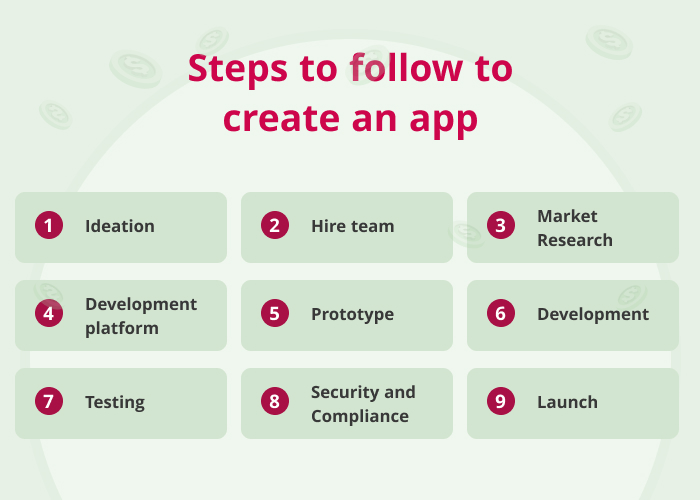Tips to create an app at low cost
Creating an app on a budget requires careful planning, resource optimization, and strategic decision-making. Here are some tips on how to create an app at a low cost:
- Clear Project Scope: Define a clear and concise scope for your app. Prioritize essential features to minimize development time and costs. Avoid unnecessary functionalities that can be added in future updates. Thus, it’s better to launch MVP before the final app product.
- Open-Source Tools and Libraries: Leverage open-source frameworks and libraries to reduce development time and costs. Explore platforms like GitHub for readily available resources. Ensure compliance with open-source licenses.
- Cross-Platform Development: Consider cross-platform development frameworks like React Native. Build once and deploy on multiple platforms to save time and resources. Ensure the chosen framework meets your performance requirements.
- Outsource Development: Explore outsourcing development to countries with lower labor costs like India. Choose a reputable outsourcing partner with a proven track record. Clearly communicate your requirements and expectations.
- Hire freelance developers: Utilize platforms like Upwork or Freelancer to find skilled professionals. Furthermore, clearly define project requirements and milestones.
Steps to follow to create an app

- Ideation: Firstly, get an idea of what you want to build. How to bring innovation in the app industry. Second, list out the idea and requirements of the app you want to build. Be clear about what you want to build
- Hire team: Hire a development team or dedicated developers from an app development company to create an app. You can find developers from freelance platforms, job portals, or through references.
- Market Research: The hired team of professionals would do market research and gather the information. Furthermore, they will define the technical architecture of your app.
- Choose a development platform: Decide if you’ll use native, hybrid, or web development. Select the programming languages, frameworks, and tools. Consider using open-source resources to save costs. Ensure compatibility with your chosen platform.
- Prototype: Develop a basic prototype to visualize the app’s core features. Create high-fidelity designs based on the wireframes. Pay attention to branding, color schemes, and overall aesthetics. Ensure a seamless and visually appealing user interface.
- Development: Break down the development process into sprints. Thereafter, the team will code the backend and frontend components. Implement features according to the defined roadmap.
- Testing: The team will conduct thorough testing for functionality and performance. They will test on various devices and platforms
- Security and Compliance: Implementation of security measures to protect user data will be done.
- Launch: Create marketing materials and assets. Develop a launch strategy, including a release plan. Furthermore, set up analytics to track app performance. Publish your app on the chosen platform(s). Monitor initial user feedback and address any issues. Implement post-launch marketing strategies. Consider user feedback for future enhancements.
Conclusion
Remember, prioritizing essential features, leveraging open-source tools, exploring cross-platform development, and optimizing resource utilization are key components of a cost-effective approach. Additionally, embracing an agile methodology, outsourcing specific tasks, and utilizing cloud services contribute to an efficient and economical app development process.
While cost-effectiveness is crucial, it’s equally important to strike a balance between affordability and maintaining high-quality standards when you create an app. Focus on providing value to your users, gathering feedback, and iterating on your app to ensure its long-term success.
FAQs
Can I create an app without any coding skills?
Yes, you can explore no-code or low-code platforms that allow you to create functional apps without extensive coding. However, for more complex applications, some coding knowledge or the assistance of a developer may be necessary.
How do I find a reliable outsourcing partner for app development?
Research potential outsourcing partners thoroughly, considering their past projects, client reviews, and expertise. Platforms like Upwork or Freelancer can connect you with freelance developers or development teams. It’s essential to clearly communicate your project requirements and expectations.
Is cross-platform development suitable for all types of apps?
While cross-platform development offers efficiency and cost savings, it may not be suitable for highly specialized or resource-intensive apps. Evaluate the specific requirements of your project and consider factors like performance, user experience, and the need for platform-specific features.
How do I handle post-launch support and updates cost-effectively?
Prioritize user feedback and identify critical updates. Utilize cloud services for scalable hosting, and consider a phased approach to adding new features. DIY marketing can also help maintain user engagement without significant costs.
Are there hidden costs in app development I should be aware of?
Yes, potential hidden costs may include licensing fees for certain tools, unexpected infrastructure costs, and post-launch marketing expenses. Conduct thorough research and factor in all possible costs during the planning stages.
Ravi Bhojani is the Chief Marketing Officer (CMO) at Alian Software, where he spearheads the company’s marketing strategies and drives its brand presence in the competitive IT services landscape. With over a decade of experience in the technology and marketing sectors, Ravi has consistently demonstrated his ability to blend innovative marketing techniques with deep industry knowledge to deliver outstanding results.